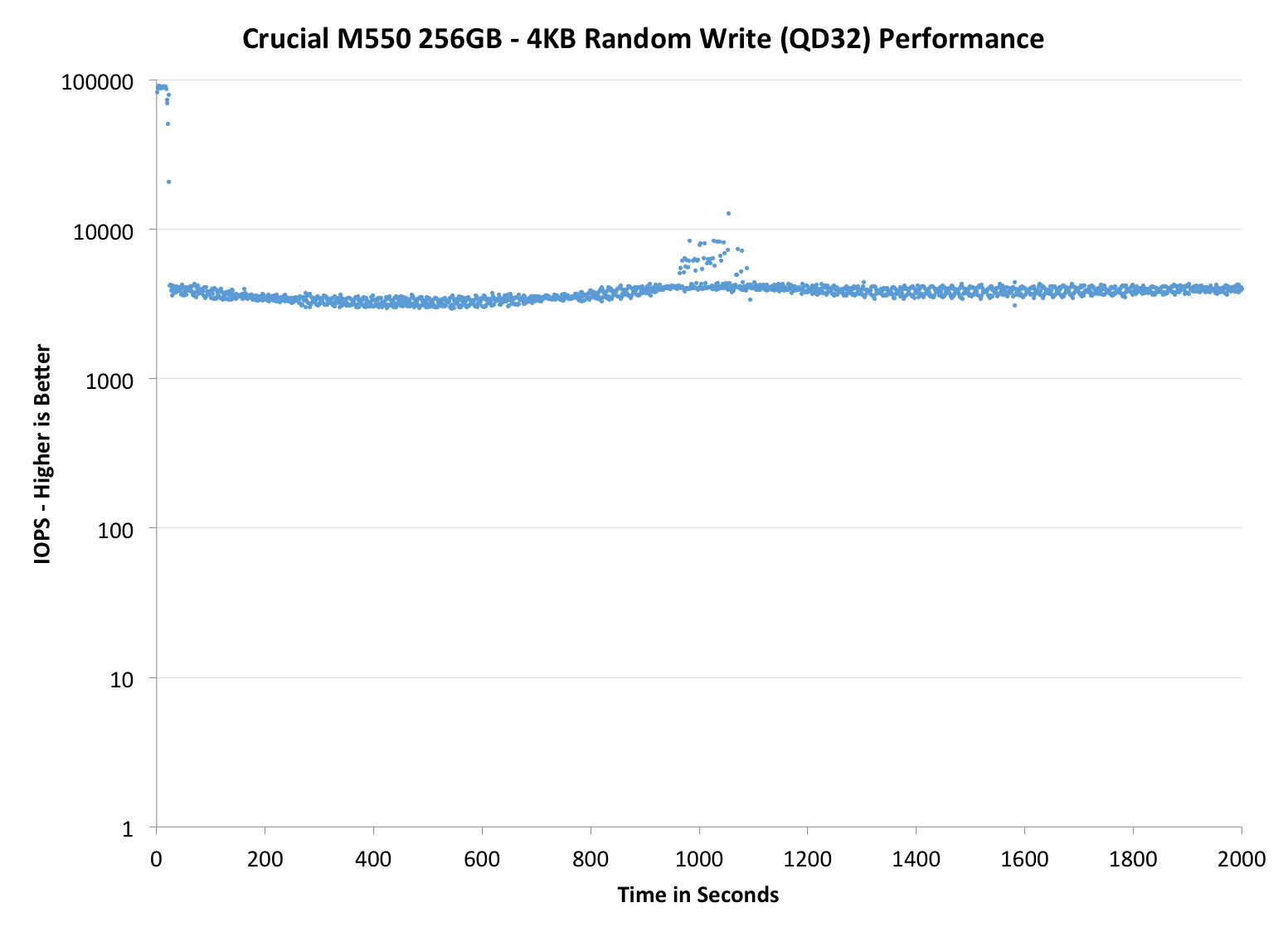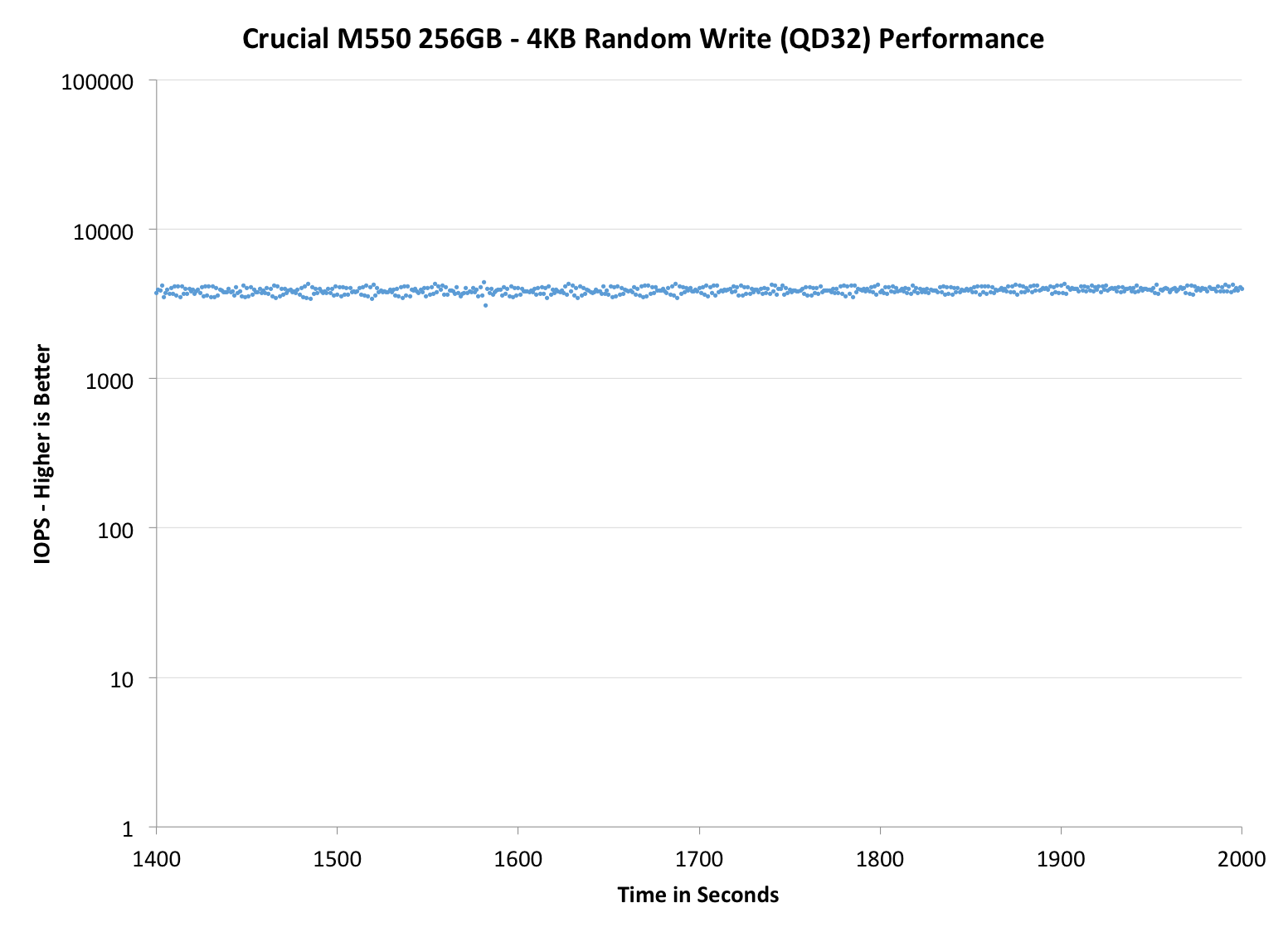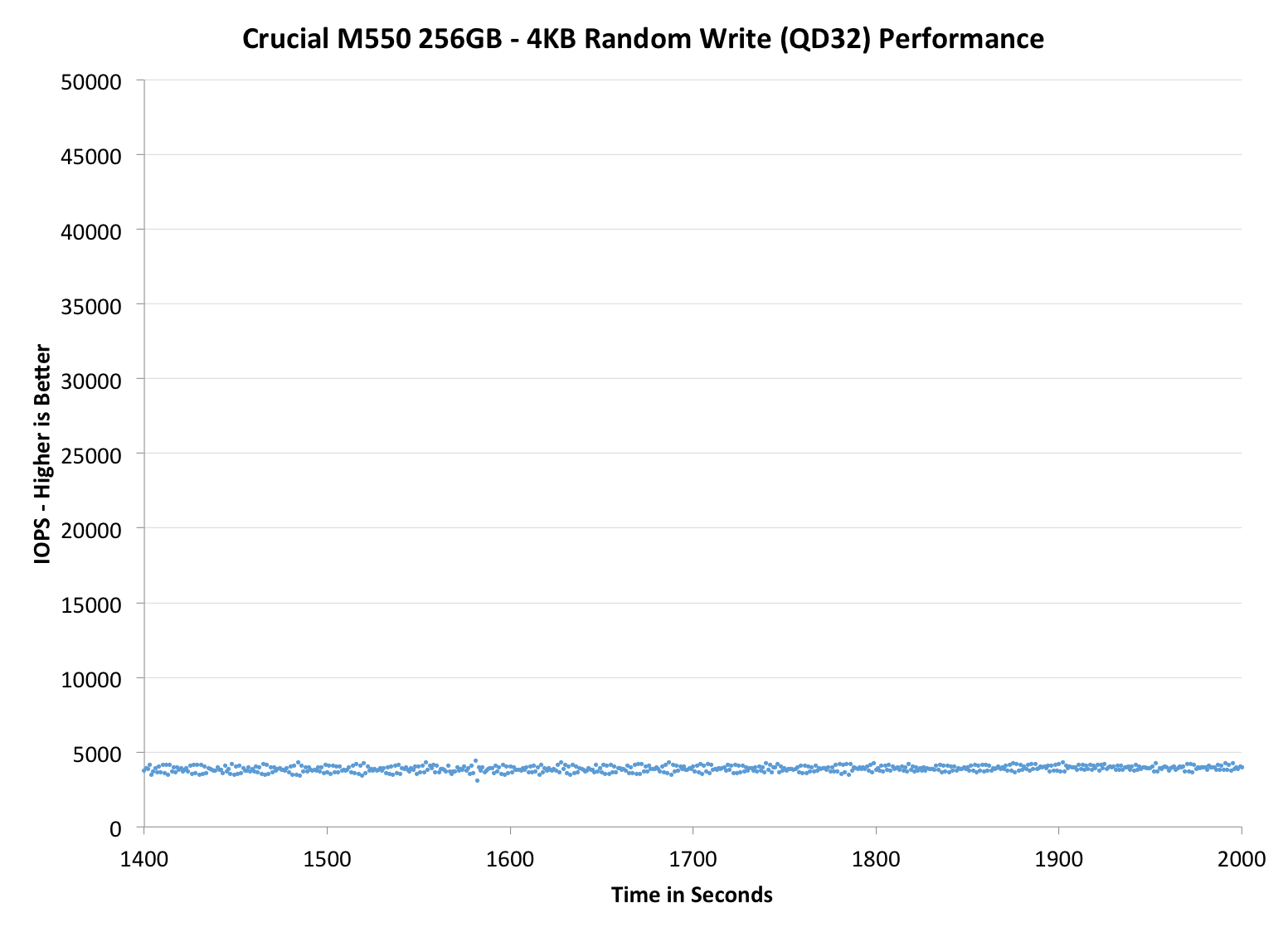Crucial M550 Review: 128GB, 256GB, 512GB and 1TB Models Tested
by Kristian Vättö on March 18, 2014 8:00 AM ESTPerformance Consistency
Performance consistency tells us a lot about the architecture of these SSDs and how they handle internal defragmentation. The reason we don’t have consistent IO latency with SSD is because inevitably all controllers have to do some amount of defragmentation or garbage collection in order to continue operating at high speeds. When and how an SSD decides to run its defrag or cleanup routines directly impacts the user experience as inconsistent performance results in application slowdowns.
To test IO consistency, we fill a secure erased SSD with sequential data to ensure that all user accessible LBAs have data associated with them. Next we kick off a 4KB random write workload across all LBAs at a queue depth of 32 using incompressible data. The test is run for just over half an hour and we record instantaneous IOPS every second.
We are also testing drives with added over-provisioning by limiting the LBA range. This gives us a look into the drive’s behavior with varying levels of empty space, which is frankly a more realistic approach for client workloads.
Each of the three graphs has its own purpose. The first one is of the whole duration of the test in log scale. The second and third one zoom into the beginning of steady-state operation (t=1400s) but on different scales: the second one uses log scale for easy comparison whereas the third one uses linear scale for better visualization of differences between drives. Click the buttons below each graph to switch the source data.
For more detailed description of the test and why performance consistency matters, read our original Intel SSD DC S3700 article.
 |
|||||||||
| Crucial M550 | Crucial M500 | Intel SSD 730 | SanDisk Extreme II | Samsung SSD 840 EVO | |||||
| Default | |||||||||
| 25% Spare Area | - | ||||||||
I can't say I'm very pleased with the IO consistency of the M550. There is a moderate increase (~4K IOPS vs 2.5K in M500) in steady-state performance but other than that there isn't much good to say. All the other higher-end drives run circles around the M550. I should note that the M550 does have considerably less over-provisioning than the other drives but even at 25% OP the results aren't pretty. There is huge variation in performance and the graphs with additional spare area certainly look quite abnormal, but the IOPS is still mostly below 5000. There are peaks of over 50K IOPS too but personally I would prefer a steady line (like the SSD 730) instead of this constant up and down. In client workloads the variation in IOPS isn't as critical as in the enterprise (where predictable performance is a must) but there can be an impact on performance in IO intensive scenarios.
 |
|||||||||
| Crucial M550 | Crucial M500 | Intel SSD 730 | SanDisk Extreme II | Samsung SSD 840 EVO | |||||
| Default | |||||||||
| 25% Spare Area | - | ||||||||
 |
|||||||||
| Crucial M550 | Crucial M500 | Intel SSD 730 | SanDisk Extreme II | Samsung SSD 840 EVO | |||||
| Default | |||||||||
| 25% Spare Area | - | ||||||||
TRIM Validation
To test TRIM, I took a secure erased drive and filled it with sequential data. Then I tortured the drive with 4KB random writes (QD32) for 30 minutes followed by a TRIM command (quick format in Windows). Finally I measured performance with HD Tach to bring you the graph below:
And as you should expect, TRIM works.











100 Comments
View All Comments
Cerb - Sunday, March 23, 2014 - link
It's just that Samsung and Sandisk/Toshiba developed that technology for their flash, and Micron/Intel decided to go all in to making it denser, instead. There's nothing "Pro" about the 840, nor Toshiba's Q, with a, "Pro," after them, other than the name. Hell, gaming video cards have had "Pro" suffixes.Samsung and Toshiba/Sandisk decided to develop and use that kind of technology (it's in the Q series, with no marketing at all, and in Sandisk's Ultra Plus (X110?) and Extreme II (X210?) as ncache), while Intel/Micron went all in for density and cost, instead.
It's generally useful, as it can allow a first stage of buffering to fake SLC, so live data writes generate less wear. So, bursty writes and random writes can both perform better, and wear the flash out less, than if it were pure TLC or MLC. I suspect it will find its way into server products over the next few years, as well, if it's not already hiding in something of Toshiba's.
Also, just as there's been increased demand for 7200 RPM SATA and SAS for professionals, plain SATA SSDs are all most users need, as well. Pro users are using the same classes of drives as consumers, for the most part.
JBVertexx - Tuesday, March 18, 2014 - link
I also agree this is positioned as a mainstream drive but with the additional performance and features upping the ante.It's hard to argue with price. The last several SSDs I have purchased have been the M500 240GB model. The current price of the 550 is what the 500 was only 3 months ago. So I would expect the positioning of the 550 to continue the price/value leadership position as it eventually replaces the M500. My bet is that the volumes of M500s that have been selling for them support this positioning as a winning one for Crucial.
MrSpadge - Tuesday, March 18, 2014 - link
Agreed - the M500 is really putting price pressure on everyone else. For this benefit I can live with slightly lower performance. If M550 at 120/240 GB comes even close in price it's a default win. It has to be cheaper than 840 Evo, though.trichome333 - Wednesday, March 19, 2014 - link
Agreed, just got a 240gb M500 for $115. Read is up there with any SSD which is all I care about.laviathan05 - Tuesday, March 18, 2014 - link
On a personal note, as a person who bought a new Samsung EVO 1TB drive yesterday, I'm pleased with this review. Also, if you follow the link in the pricing chart you'll see that it currently is selling for $470 on newegg.Jaguar36 - Tuesday, March 18, 2014 - link
In your final words you mention that "It has the best-in-class encryption support", How come you don't say anything else about this in the article? What exactly does best in class mean?Kristian Vättö - Tuesday, March 18, 2014 - link
"There is TCG Opal 2.0 and IEEE-1667 support, which are the requirements for Microsoft's eDrive encryption."It's something we've covered before so I only mentioned it in the review. Clicking the eDrive link leads to an article where the M500 is tested with eDrive, so you'll see the benefits there.
Jaguar36 - Tuesday, March 18, 2014 - link
Thanks!just4U - Tuesday, March 18, 2014 - link
When looking at SSD's to purchase I settled on 3 Intel, Samsung, and Crucial. The controller on the Intel and the fact that it was priced in the range of the Samsung led to me dropping it as a choice. So that left me with Samsung/Crucial. Given the choice I'd go Samsung.. as it is a higher performing drive but price/availability I wouldn't be to terrible upset if I had to go with the Crucial drives.I think maybe they just let performance take a back seat because their other drive was popular even though it was slower than the rest of the pack. It gained a good reputation so their hoping that will carry over to this new slightly faster/feature rich incarnation.
extide - Tuesday, March 18, 2014 - link
Were you talking an Intel SF drive (300/500 series?) or the 720, with the super sweet in-house controller? Also don'[t forget about the Sandisk Extreme II...IMO The Top Tier performance drives are (In no specific order):
Sandisk Extreme II
Intel 720 Series
Crucial Neutron GTX
Samsung 840 Pro
Seagate 600
OCZ Vector 150
And the best in terms of capacity/price:
Crucial M500 (& M550?)
Samsung 840 EVO